Table of Contents
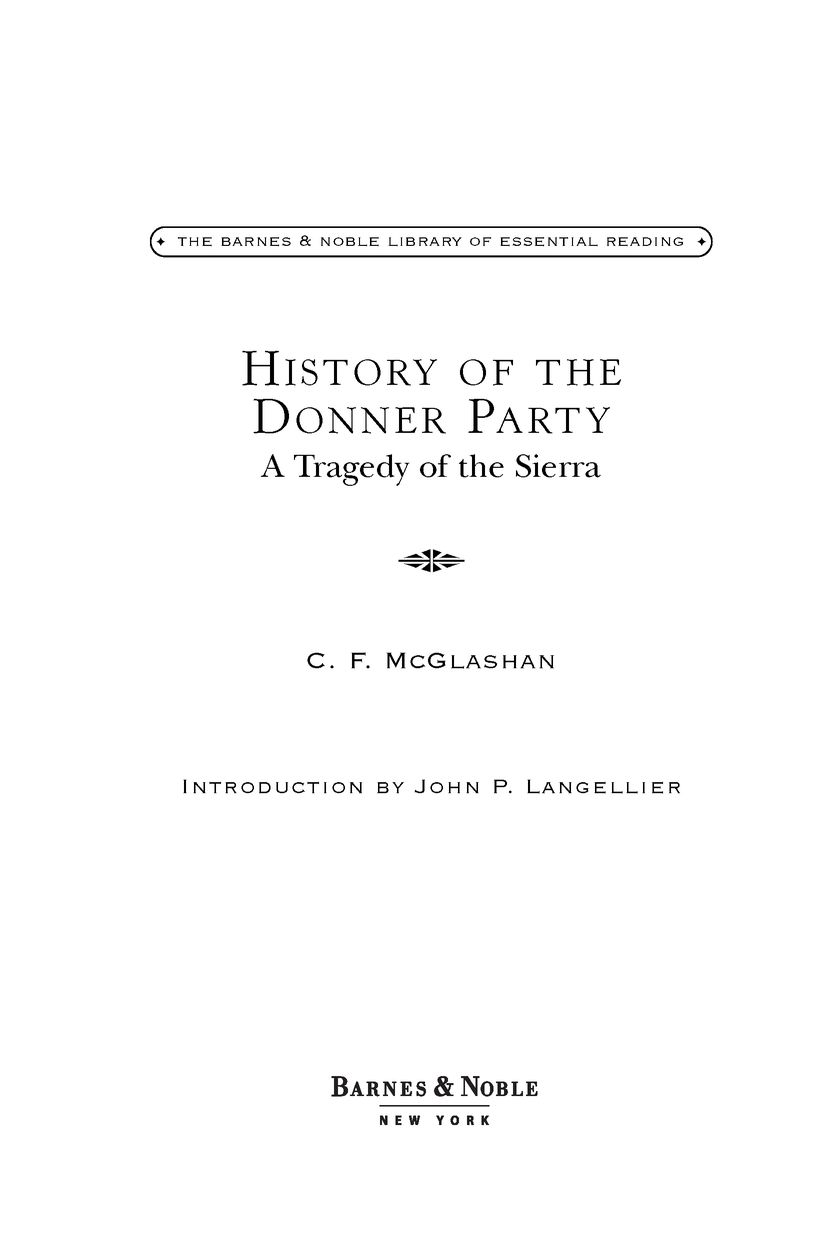
INTRODUCTION
WITHIN TWO WEEKS OF ITS ORIGINAL PRINTING, THE ENTIRE PRESS RUN of Charles Fayette McGlashans History of the Donner Party (1880) had been purchased. The first book devoted to an accursed emigrant band who had been drawn to California in the antebellum era, McGlashans volume continues to shed light on this dark saga more than a century after its debut. Since that time, this publication, which the author based on first-hand accounts and personal interviews with twenty-four survivors, has appeared in more than a dozen editions. The reason for these many reprints stems in large part from McGlashans unprecedented access to those who lived through an unimaginable ordeal that reduced some to the unthinkablecannibalism.
A native of Janesville, Wisconsin, McGlashan was born in 1847, a year after prominent sixty-two year old Springfield, Illinois, resident George Donner and his brother succumbed to California fever. The brothers and twenty-five other men, seventeen women, and forty-three children were caught up in the tide of Manifest Destiny, a powerful concept that swept the nation with an almost religious fervor. The lure of lush lands, verdant forests, adventure, and other compelling promises fueled the imaginations of thousands of Americans living east of the Mississippi River. The Donner family, as well as other families including the Breens, Eddys, Graves, Kesebergs, McCutchens, Murphys, Reeds, Wolfingers, and a few unmarried men who were hired on as teamsters, therefore, joined a steady stream of humanity willing to uproot from their relatively secure lives to brave the unknown.
Ahead of twenty-three oxen-pulled wagons full of families in quest of California lay 2,500 miles of prairies, mountains, and deserts. During this period some promoters, including Lansford Hastings, touted the future Golden State as the garden of the world. An attorney turned would-be empire builder, Hastings wrote The Emigrants Guide to Oregon and California (1845) with the goal of triggering a mass exodus of American settlers bound for the West Coast.
George Donner numbered among those who responded to Hastings persuasive prose. Armed with a copy of The Emigrants Guide, enthusiastic, self-confident, and successful businessman Donner evoked the aura of a patriarch. His demeanor instilled trust in many of his fellow travelers, and they elected him as their groups captain. Thus Donners name became inextricably linked with the doomed pioneers.
This choice was but one of the ill-conceived decisions that would lead to catastrophe. Donner lacked the experience to conduct a band through unfamiliar, harsh territory. Unlike knowledgeable frontiers-men such as former U.S. dragoon officer and savvy mountain man James Clyman, who had traversed much of the Rocky Mountain region, Donner relied solely on second-hand information. In particular he followed Hastings recommendations, as did many members of the party who failed to realize the flawed information found in this small, but influential pamphlet. Among Hastings inaccurate pronouncements was his adamant assertion that a shortcut to California existed to the south of the more commonly trod road to the Pacific.
While Clyman argued against this route, the Donner Party ignored such sage advice. Rather they followed Hastings advice, a move that all but sealed their destiny. They embarked into the arid wastes of Utah, a decision that almost claimed all their lives were it not for their timely rescue by a band of volunteers who brought them water.
This brush with death likewise cost the party valuable time. They arrived at the base of the mountains, which had to be scaled before snows made them impassable, with winter quickly approaching. To make matters worse, as they came upon the barrier of the Sierras, Piute Indians killed more than two dozen of the oxen required to haul the wagons over the steep passes before them. The loss of a substantial number of their livestock slowed the partys progress even further.
In late October 1846, despite the urgency to press on, the wagon train halted for nearly a week to rest after the grueling trial in the desert. They delayed in the Truckee basin at the very time the first storms set in, cutting them off and stranding them. The incredibly harsh weather, inadequate shelter, and a rapidly dwindling food supply ultimately spelled disaster.
By January 1847, in desperation some of the stranded survivors trudged over the 7,088 foot pass (now Donner Pass) through the mountains in hope of bringing aid. Ultimately, their grueling efforts, and other circumstances brought relief parties, whom themselves faced harrowing challenges before coming to the rescue of the forty-eight emaciated, forlorn survivors during the bitter cold of April.
Fortunately McGlashan, who in 1849 had come to California as a two-year old, did not share the unfortunate fate of the eighty-seven members of the Donner Party. Instead his journey to California and early years there for the most part proved calm. Growing up and reaching early manhood in his adopted state, he became a resident of Truckee, California, by 1871. McGlashan spent most of the next six decades in that community as a lawyer, local booster, politician, naturalist, inventor, and newspaperman. It was this latter pursuit that brought about his decision to run a serial related to the Donner episode for the Truckee Republican, the paper he edited in the mid- 1870s. He hoped the advance announcement of this project would bolster declining readership for the paper because the subject of the Donners was widely known in the area. As such, McGlashan reasoned there would be built-in interest among his audience.
McGlashan barely had released publicity for the proposed stories when subscriptions jumped in anticipation of the series. In response, during 1879, McGlashan hurriedly printed a brief version of the project in a special edition of the paper. At the time he had little to draw on for his text except for a few previously published sources. These included Edwin Bryants What I Saw in California, an account released in 1848 by a man who had been with the Donners on part of the journey through Kansas and Nebraska, and a chapter from J. Quinn Thorntons book Oregon and California in 1848 that presented a grisly tabloid-like rendition printed in 1849.
His first foray into the topic provoked a backlash from at least one of the Donner family members. Benjamin Wilder, the late George Donners son-in-law, questioned McGlashans accuracy. He called for a meeting of survivors to review the matter. McGlashan responded in the May 20, 1879, issue of the Republican that he had taken great pains to publish all the important facts of the history in his paper and as an error appears is corrected forthwith.... Not content to let the matter rest, McGlashan continued his investigation. Besides reviewing letters, journals, and written materials, he sought out members of the Donner wagon train and others with direct knowledge of one of the most tragic events of the Westward movement. He succeeded in locating dozens of informants. In a number of instances he obtained extensive cooperation from those who remained alive or from their descendents. Among them, Judge James Breen, one of Patrick Breens children, supposedly encouraged McGlashan to set the record straight. The result was an expanded and greatly altered version from his original writings. McGlashans second effort also painted a more positive and detailed picture than previous publications and oral tradition had provided.
At first McGlashan received praise for the thoroughness of his revised work. In fact, Hubert Howe Bancroft, whose extensive late Victorian era encyclopedic studies of the American West set the standard for generations of historians, enthusiastically effused: C.F. McGlashan published a volume on the subject [of the Donner Party] in 1879, treating it in a manner that has left little or nothing to be desired.


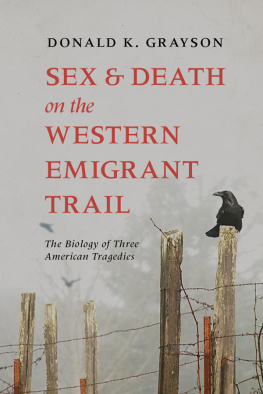
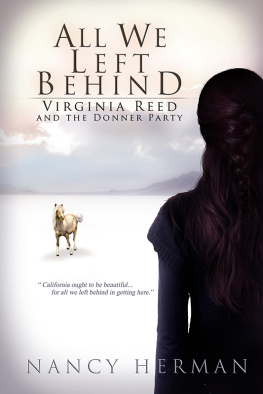

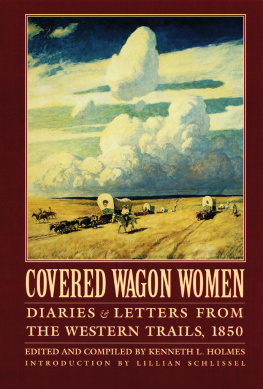
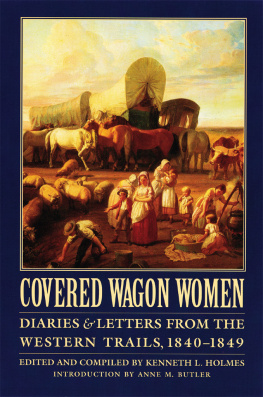
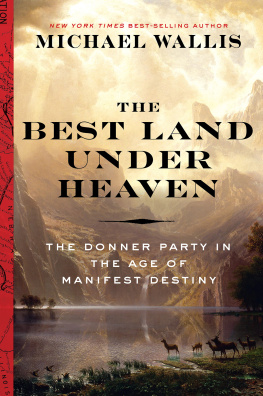
![Blackstone Audio Inc. - Ordeal by hunger: [the story of the Donner Party]](/uploads/posts/book/167807/thumbs/blackstone-audio-inc-ordeal-by-hunger-the.jpg)

